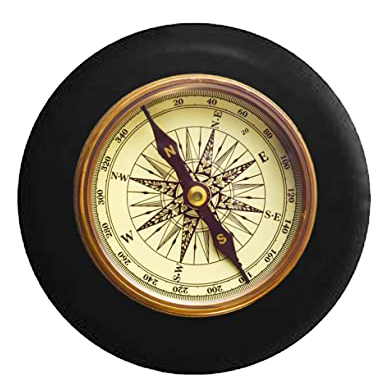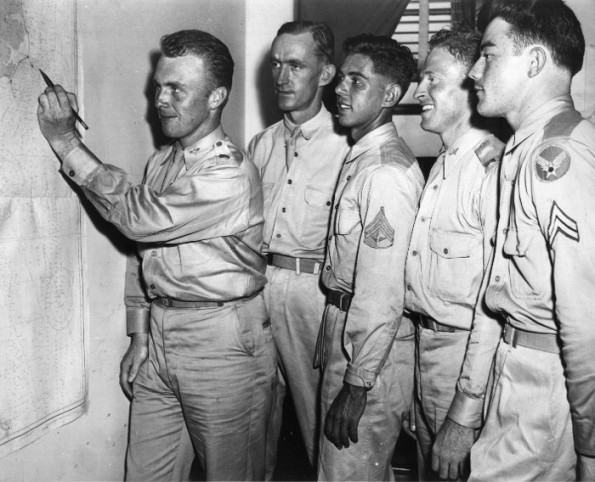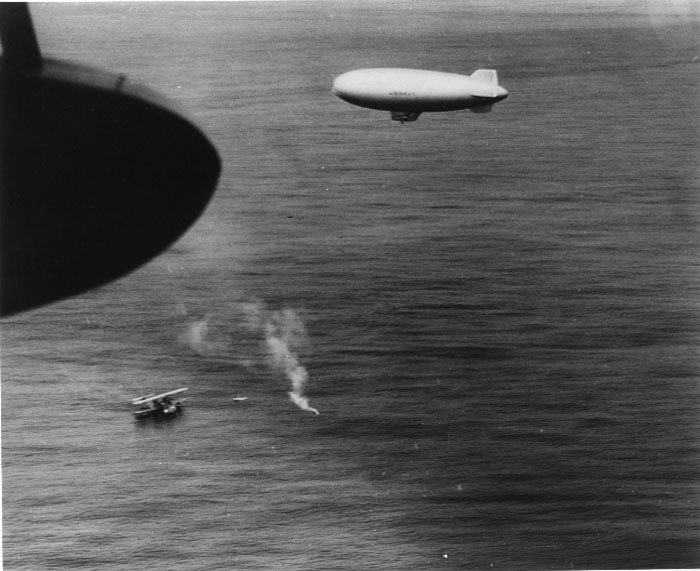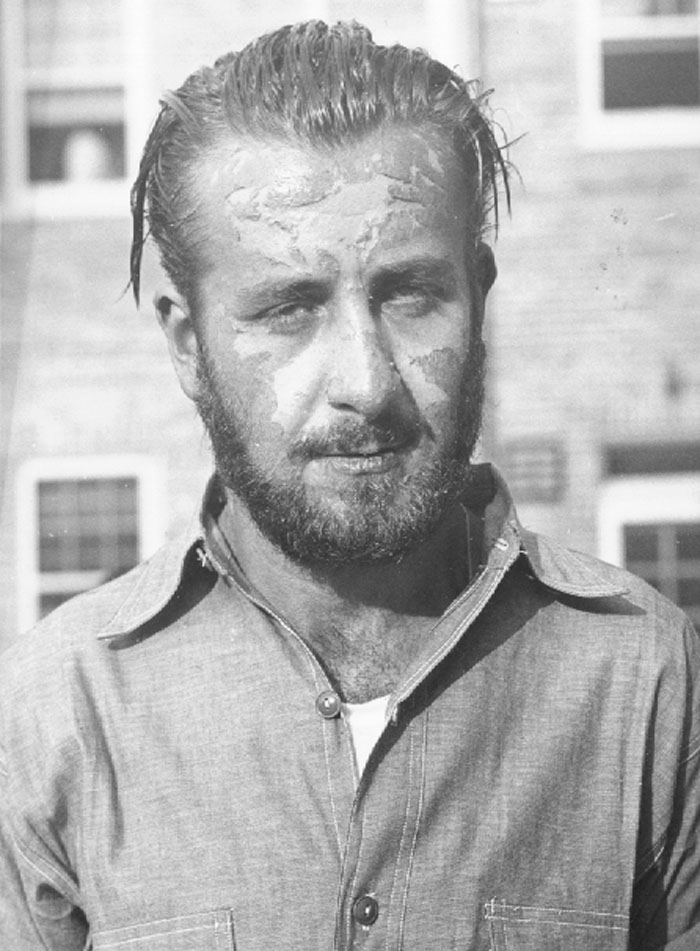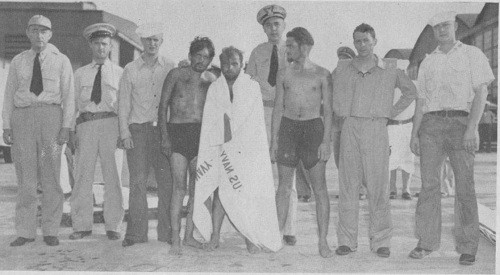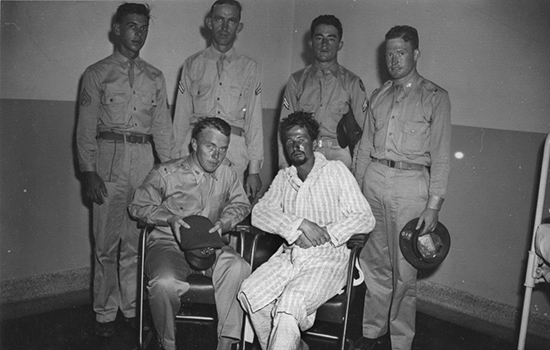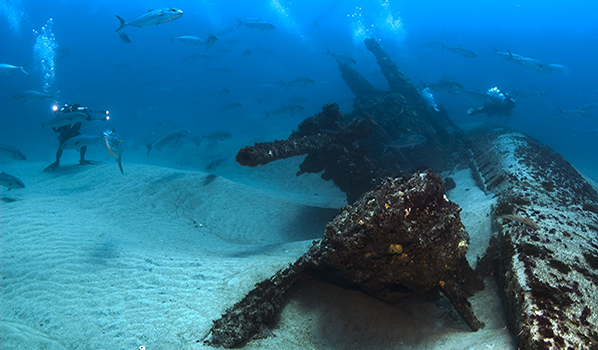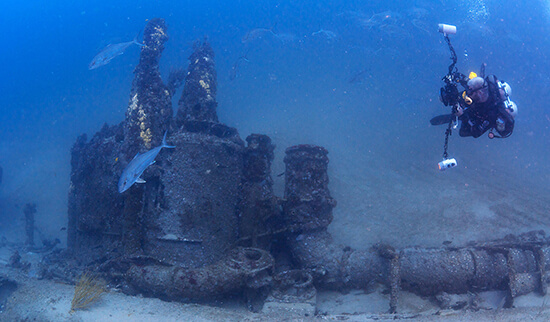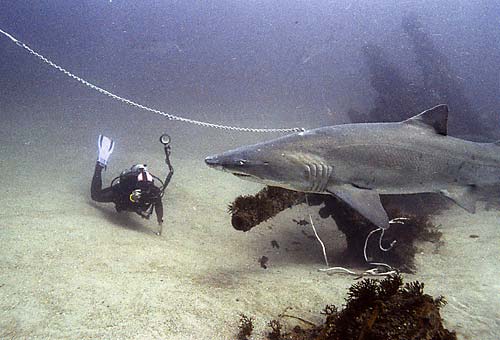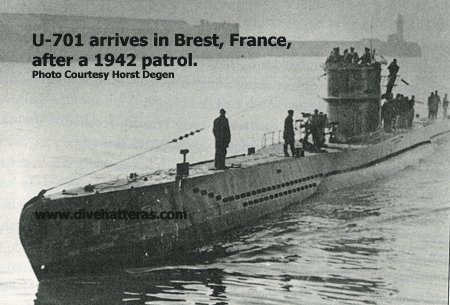
The U-701 arriving in Brest, France. Photo: Courtesy of Horst Degen.
The Sinking of the U-701:
The U-701 was launched on April 16, 1941. In charge of the U-boat was Kapitänleutnant Horst Degen. Degen was a graduate of the German naval academy and had eight years of experience at sea. He originally was a member of the destroyer division. His first assignment on a U-boat he served under Erich Topp on the U-552. According to the Office of Naval Intelligence (ONI), Degen was seen as being daring and reckless "which are the peculiar attributes of the more successful U-boat commanders...a philosophy of combat which insists on retention of the offensive, admitting little evasive action."
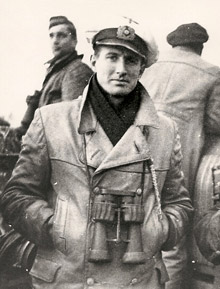 Kapitänleutnant Horst Degen
Kapitänleutnant Horst Degen
The U-701 on its launching had numerous troubles right away. First if failed sea trials in the Baltic and had to return to the shipyard to be overhauled. Problems that it experience included the air and oil lines were not properly fitted and the electrical circuits were wired wrong. It took another three months to finally be ready to set sail. The next month was spent with target practice and torpedo practice. After this concluded the U-701 spent another time in the dock at the ship builder's before finally given the go-ahead to be on duty. In total, it spent five months of its new life before it could begin its first war cruise.
U-701 finally headed out on December 27, 1941. Its first patrol resulted in the sinking of Baron Erskine which occurred between January 2 and January 7, 1942. However, during this first patrol, one of Degen's officers was washed overboard in heavy seas. On their second patrol to the North Atlantic two anti-submarine trawlers, HMS Notts Country and HMS Stella Capella were successfully sunk. What made this patrol stand out for Degen was these attacks were done in broad daylight and in the presence of an armed escort. it also sunk a fishing trawler, Nyggjaberg.
After this patrol, the U-701 returned to Lorient, France to top off their fuel tanks on May 20, 1942. After topping off, they immediately head to the American east coast. The crew of the U-701 consisted of four officers, a midshipman, and 28 men. The Atlantic crossing took three weeks. On its way over it came in contact with the Portuguese sailing ship, the Gazella Primera that was headed to Newfoundland to fish. Due to Portugal being a neutral country it was allowed to pass without incident. U-701 also chased two large liners with one being the Swedish Drotningholm which was traveling under diplomatic immunity. The other ship went unidentified due to it outrunning the U-701.
The U-701's mission was to lay mines in the Chesapeake Bay area. They began this mission on June 12, 1942. It proceeded to lay 15 mines and completed this task in thirty minutes. The mines were in 36 feet of water directly in the shipping channel. The laying of these mines produced results for the U-701. As the result, two ships were sunk and three ships were severely damaged. According to Degen after being captured upon arriving off the east coast (June 12, 1942) the U-701 was caught on the surface by a patrol plane. The U-boat immediately crashed dived to avoid being hit. By the time it reached forty feet below the surface, five depth charges went off near the hull. Degen stated, "Lights failed and instrument glasses were smashed in the control room, but the damage was slight and quickly repaired." Apparently, the men were pretty shaken up by the attack.
After its mining mission was completed, the U-701 headed for the waters of Cape Hatteras. On June 19, it was involved in a fierce gunfight with the U.S. Navy patrol boat, USS YP-389. As a result of this battle, the patrol boat was sunk. On June 26, they torpedoed the Norwegian freighter Tamesis and followed up the next day firing upon the British tanker British Freedom. These ships were damaged but did not sink. On June 28 the U-701 encountered William Rockefeller, one of the largest tankers in the world. This time it was successful in sinking a ship. The U.S. Coast Guard aircraft arrived on-site and dropped two depth charges. It then summoned the U.S. Coast Guard Cutter #470. It too began to drop depth charges in hopes of destroying the attacking U-boat. The only thing it did was keep the U-701 away. However, the U-boat returned and fired one more torpedo which sealed the fate of William Rockefeller.
For the next nine days, the U-701 patrolled with no results. The crew suffered from boredom and sickness. The only action it saw was to resurface from time to time to ventilate the boat. The air circulators having previously been damaged by depth charges dropped by St. Augustine (a converted yacht) on June 27, 1942. With the air circulators being out of commission there was a constant build-up of heat aboard the U-boat.
On July 7, the skies were clear and the sea was smooth. Four lookouts were in the conning tower scanning the area through binoculars. Those on the lookout included Degen, Lieutenant Junker, Ensign Bazies, and Warrant Quartermaster Kunert. Junker then observed, "Airplane, there!" Bazies and Kunert dove down the hatch. Degen responded to Junker by stating, "You saw it too late." At which time Junker replied, "yes." After everyone had gotten below the U-701 went into a crash dive. No sooner did they begin this dive when the explosions of three aerial depth charges went off. The damage was severe enough that the U-boat couldn't blow out its ballast tanks and surface.
The plane was an Army A-29 bomber #9-92-392. It was attached to the 396th Bombardment Squadron at Cherry Point Field, North Carolina. Onboard the bomber was Second Lieutenant Harry Kane (Pilot), Second Lieutenant Murray (Navigator), Corporal C.E. Bellamy (bombardier), Corporal L.P. Flowers (Radio Operator), and Corporal P.L. Broussard (Engineer). The plane was equipped with one 50-caliber and five 30-caliber machine guns, and three 325-pound depth charges in its bomb carriage.
According to Degen's interrogation statement, " the submarine was approximately five meters under the surface when the first bomb made a direct hit on the topside of the stern of the submarine, tearing a large hole which put out of commission the first engine and caused water to rush in. The second bomb made a direct hit on the topside just aft of the conning tower which tore a large hole and put out commission all of the engines and mechanisms."
Another report from P.O.W. Kapitänleutnant Horst Degen while held at Camp Devens, Massachusetts went on to say, "2 bull's eyes - air bombs. All instruments went out of order. Tanks blown. Within 1 to 2 minutes control room and conning tower filled with water. Ship had list to starboard of approximately 20 degrees. C/T hatch opened easily. Ship is at a depth of about 15-20 meters and no longer able to surface. Depth of water about 80-100 meters."
Survivors' recollections of the sinking were somewhat incoherent. One torpedo man said he fell asleep in the bow compartment at the time of the attack. He went on to state that the main lighting failed, but the emergency lights were still on. He made his way to the control room to ask whether to abandon ship. From there he headed back to the bow compartment, perhaps to get lifesaving apparatus or personnel possessions. When he returned to the control room it had already filled up with waist-deep water.
All the survivors were sure they were submerged when they reached the conning tower open. The hatch opened easily, according to Degen. Eighteen men escaped through the conning tower including the captain. According to one prisoner who said he was one of the last to leave, almost all of the crew escaped the boat. However, the way the sea was that day, the various groups couldn't see each other. Due to the urgency to flee the U-boat, all secret documents were left on the boat. Also, no attempt was made to radio signal to report the sinking of the U-boat.
Eighteen men left the boat together with three escape lungs and one life preserver. The army bomber dropped two small life preservers. Two of the men, boatswain's mate Hänsel and the midshipman, Lange, struck out for shore, 30 miles away, even though they were warned by others. The next two days were a nightmare according to the Naval Report. The stronger men saw others drown one by one. Some apparently went mad before dying. Degen didn't have a life preserver or lung when he left the boat. For a portion of the time his quartermaster, Kunert, supported him in the water. At about 9:00 PM the coxswain Etzweiler drowned due to his not knowing how to swim. As the night went on, the sea grew rougher though the water was warm.
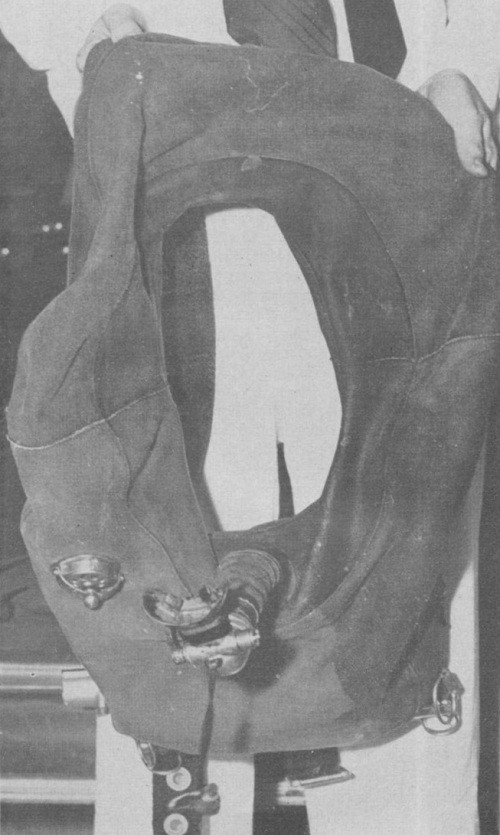 German Escape Lung
German Escape Lung
The next day, July 8 at about noon, a Coast Guard ship passed by slowly about 2,200 yards without hearing the screams of the survivors. This didn't help the cause for men to hold on. Damrow and Schmidtmeyer became delirious. One after another Damrow, Schmidtmeyer, Gründler, Bahr, Weiland, and Schuller drowned. Bahr, the engineer officer went mad before going under.
A number of planes passed over them without the survivors being spotted as the Gulf Stream carried them northward. That night Bosse and Fischer drowned. Later that night Degen's group met up with Laskowski who was wearing two escape lungs and seemed in good shape. He reported that ten more of the crew had escaped through the conning tower including two officers and Seldte (the only one of the group that survived).
During the night of July 8 and the early hours of July 9, Degen's group found a floating lemon and coconut. Vaupel with some ingenuity was able to open the coconut with the oxygen flask of his escape lung. Each man had a swallow of coconut milk, a bit of the meat, and suck of the lemon. Before dawn, Leu, Mickalek, and Laskowski drowned. Degen later recalled that one of the men, before dying, said goodbye to him: "I'm taking leave of you. Please remember me to my comrades."
The morning of July 9 a U.S. Navy blimp sighted the survivors and dropped a rubber boat and a rubber sack of provisions. Kunert, Baupel, and Grootheer climbed aboard the boat. Later they spotted the captain, unconscious, and pulled him aboard. At 4:05 PM, 49 hours after U-701 was sunk, a Coast Guard seaplane picked up the survivors. At the time of the rescue, four of them were in the raft and three others were found in the vicinity. The two groups were separated five miles apart from each other at 36°18' N., 73°32' W. At the time of their rescue, they were some 65 miles from the estimated location of the sinking.
When the survivors reached land, Degen stated that at one point during the night he sat onshore washing oil from his body when a German-speaking man approached him and told him he had been mentioned in the German High Command communique of either June 29 or 30. Obviously, a hallucination that Degen had experienced that night.
The surviving crew of the U-701 became Prisoners of War in various prison camps in the United States. When they were first brought to the land they were suffering from exposure and covered in oil. After a short period of recovery, Lt. Harry Kane and the crew of his bomber wanted to meet with Degen to apologize for not being able to provide more assistance. Noted in the picture below that meeting did occur.
The remains of the U-701 were left completely undisturbed for 47 years unit it was discovered by a sport diver, Uwe Lovas in 1989. At the Lovas contacted Horst Degen and reassured him that he would not be disturbed out of respect for his falling comrades. However, in 2004 it was rediscovered following a hurricane and has been more accessible to the diving community.
THE SHIP'S SPECIFICS:
| Built: 1941 | Sunk: July 7, 1942 |
| Type of Vessel: Type VII-C U-boat | Owner: German Navy |
| Builder: Stulcken Sohn, Hamberg, Germany | Power: Two diesel engines and two electric motors |
| Speed: 17 knots surfaced (on diesels), 8 knots submerged (on motors) | Dimensions: 218' x 20' x 15' |
| Previous Names: None | Armament: Five torpedo tubes (four bow, one stern), one 88-mm gun |
LOCATION OF THE SINKING:
Here is the location of the sinking: 35°14'21.01"N, 75°6'42.84"W
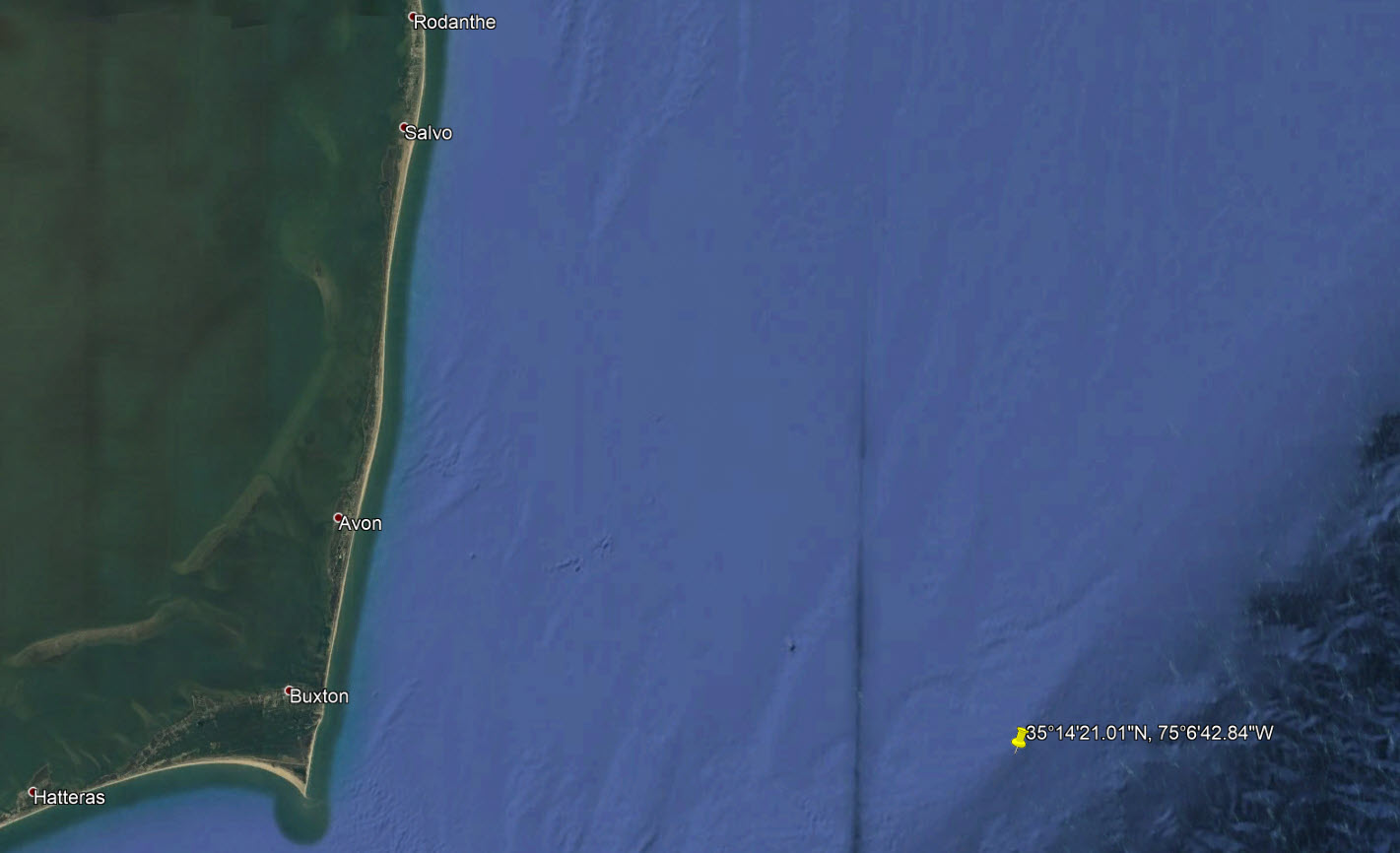
LOST CREW MEMBERS :
Total Lost: 39 Survivors: 7
| Last | First | Date of Death | Position | U.S.N. Equivalent |
|---|---|---|---|---|
| Amrhein | July 7, 1942 | do | Do | |
| Bahr | Karl-Heinrich | July 8, 1942 | Oberleutnant (Ing.) | Lieutenant (j. g.) engineering duties only. |
| Bazies | July 7, 1942 | Leutnant z. S | Ensign | |
| Birnmeyer | July 7, 1942 | Bootsmaat | Coxswain | |
| Bosse | July 8, 1942 | do | Do | |
| Braunig | July 7, 1942 | do | Do | |
| Damrow | July 8, 1942 | Maschinenmaat | Fireman, 1st Class | |
| Dominik | July 7, 1942 | Funkgefreiter. | Do | |
| Ermitario | July 7, 1942 | do | Do | |
| Etzweiler | July 7, 1942 | do | Do | |
| Fischer | July 8, 1942 | do | Do | |
| Fritz | Walter | July 7, 1942 | Obermaschinist | Warrant machinist |
| Gross | July 7, 1942 | Matrosenobergefreiter | Seaman, 1st Class | |
| Gründler | July 8, 1942 | Oberbootsmaat | Boatswain's mate, 2nd Class | |
| Hänsel | Kurt | July 7, 1942 | do | Do |
| Höhlein | July 7, 1942 | do | Do | |
| Junker | Konrad | July 7, 1942 | Oberleutant z. S. | Lieutenant (j. g.). |
| Köwing | Kurt | July 7, 1942 | do | Do |
| Kundt | July 7, 1942 | do | Do | |
| Lange | July 7, 1942 | Fähnrich (Ing.) | Ensign, engineering duties only. | |
| Laskowski | July 9, 1942 | Matrose | Apprentice seaman | |
| Leu | July 9, 1942 | do | Do | |
| Löwe | Paul | July 7, 1942 | do | Do |
| Magg | Xavier | July 7, 1942 | do | Do |
| Michalek | July 9, 1942 | do | Do | |
| Nimsch | July 7, 1942 | do | Do | |
| Peters | July 7, 1942 | Matrosengefreiter | Seaman, 2nd Class | |
| Raddatz | July 7, 1942 | do | Do | |
| Schmidtmeyer | July 8, 1942 | Maschinengefreiter | Fireman, 3rd Class | |
| Schuller | July 8, 1942 | do | Do | |
| Stadler | July 7, 1942 | do | Do | |
| Wallaschek | July 7, 1942 | do | Do | |
| Weber | July 7, 1942 | Mechanikermaat | Torpedoman's mate, 3rd Class | |
| Weiland | July 8, 1942 | do | Do |
SURVIVING CREW MEMBERS :
| Last | First | Position | U.S.N. Equivalent |
|---|---|---|---|
| Degen | Horst | Kapitänleutnant | Lieutenant |
| Faust | Bruno | do | Do |
| Grotheer | Herbert | Funkmaat | Radioman, 3rd Class |
| Kunert | Günter | Obersteuermann | Warrant quartermaster |
| Schwendel | Gerhard | do | Do |
| Seldte | Werner | Mechanikergefreiter | Do |
| Vaupel | Ludwig | do | Do |
Photos of U-701:
 Final archaeological site plan of U-701. Photo courtesy of NOAA. |
|
|
|
Coast Guard PH-2 seaplane lands to rescue U-701 survivors -Navy K-type airship overhead had earlier located the survivors and dropped a raft and supplies to the survivors. Photo courtesy of the National Archives. |
|
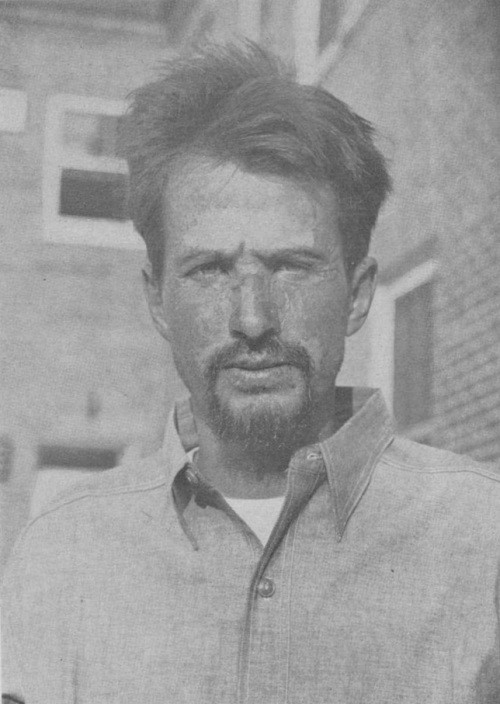 Horst Degen, Kapitänleutnant, C.O. U-701. Photo courtesy of the National Archives. |
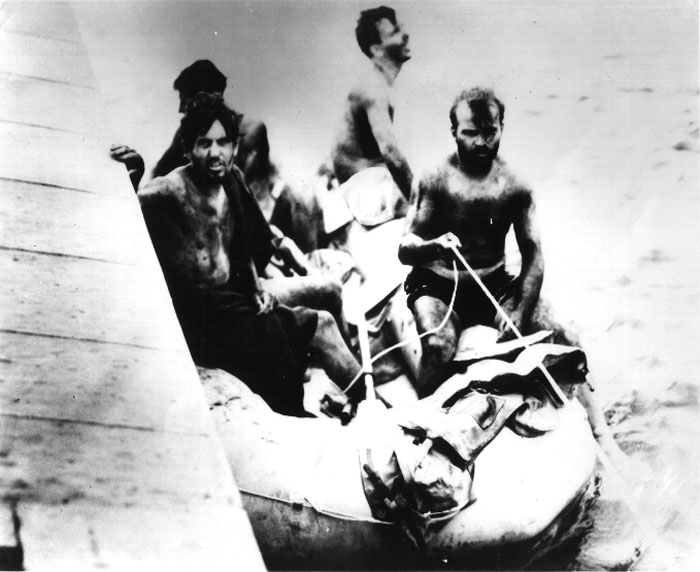
Survivors reach the PH-2 airplane. Photo courtesy of the National Archives. |
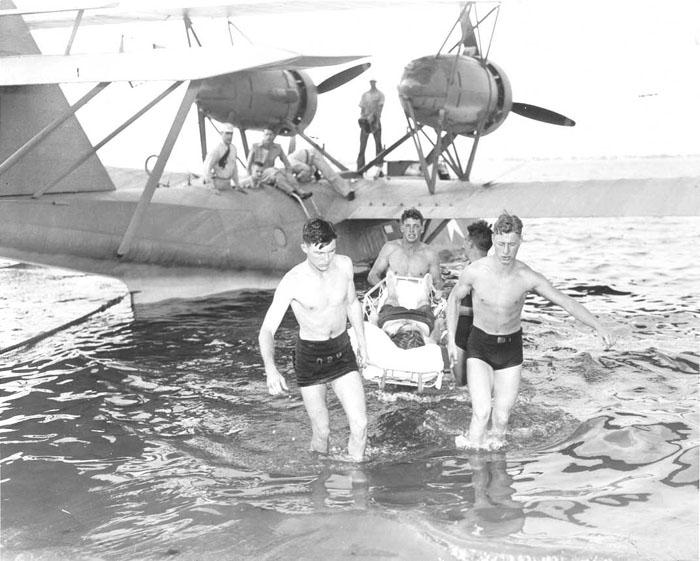
The survivors are brought ashore at NAS Norfolk, VA. Photo courtesy of the National Archives. |
|
|
|
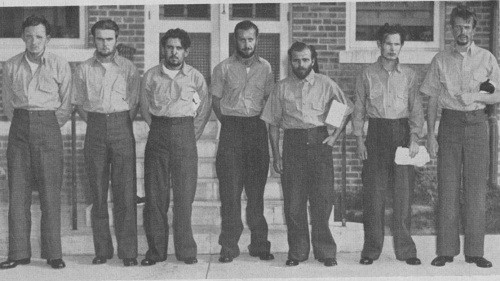 Survivors of the U-701. Kapitänlentnant Degen on extreme right. Photo courtesy of the National Archives. |
|
|
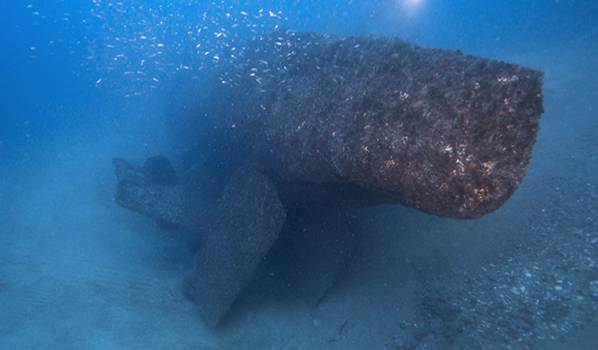 The exposed stern section of U-701. Photo courtesy of Hoyt, NOAA |
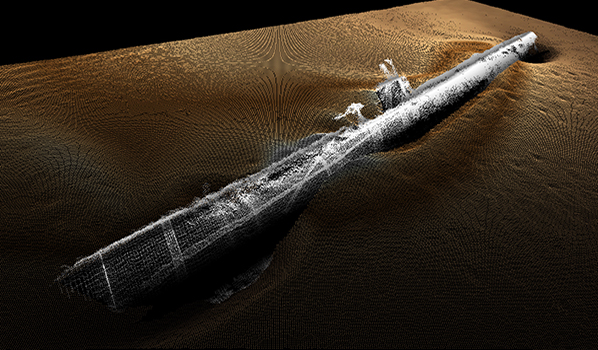
Sonar visualization of the U-701 wreck site. Photo courtesy of ADUS. |
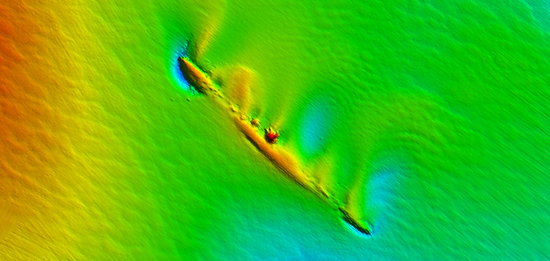
Multibeam survey of the U-701 wreck site. Photo courtesy of NOAA. |
|
|
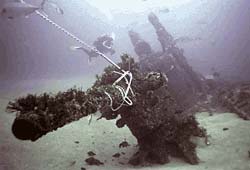
88mm deck gun mounted on the bow. Photo courtesy of Paul M. Hudy. |
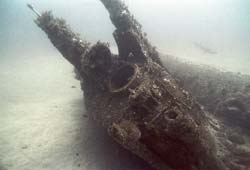 Conning tower. Photo courtesy of Paul M. Hudy.
|
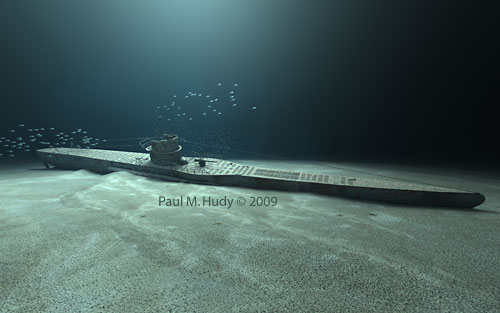 The U-701 as she likely appeared approximately one month after sinking off Cape Hatteras. Photo courtesy of Paul M. Hudy. |
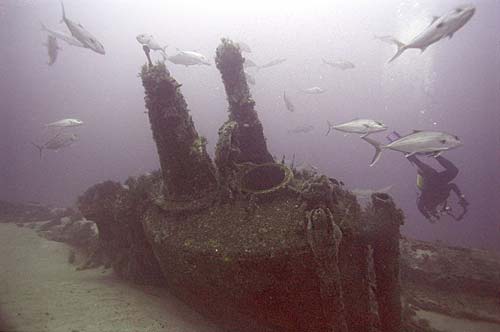 Conning tower lists to the starboard side. Photo courtesy of Paul M. Hudy. |
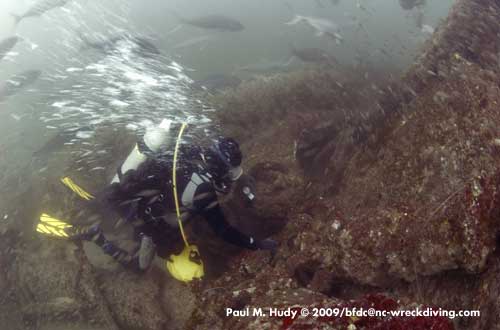 The wreck site can experience strong currents as noted by the diver's bubbles moving sideways instead of vertically. Photo courtesy of Paul M. Hudy. |
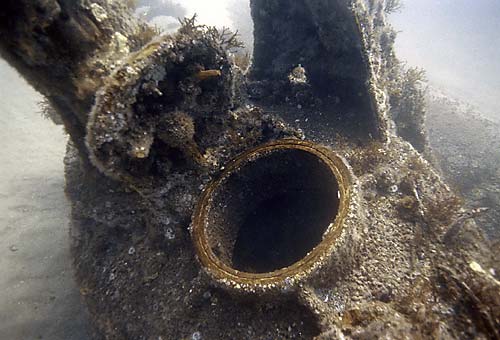 Conning tower, one filled with sand, had been dredged to cut out artifacts. Photo courtesy of Paul M. Hudy. |
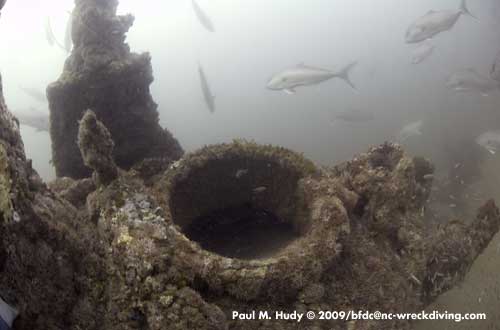 The conning tower hatch has been taken off and the conning tower appears to fill back in with sand. Photo courtesy of Paul M. Hudy.
|
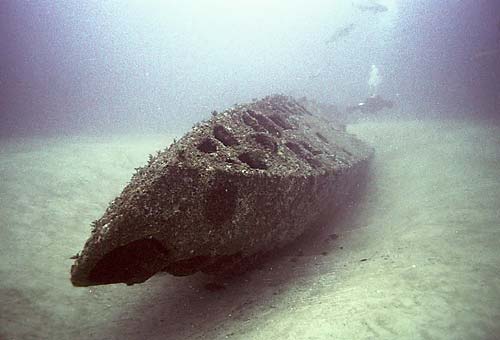 The stern exposed. Photo courtesy of Paul M. Hudy.
|
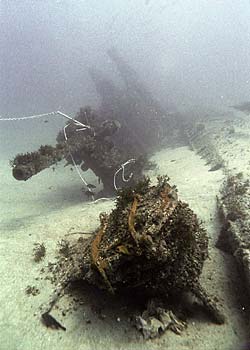 Sunk sub rescue canister forward of the gun on the port side. Photo courtesy of Paul M. Hudy. |
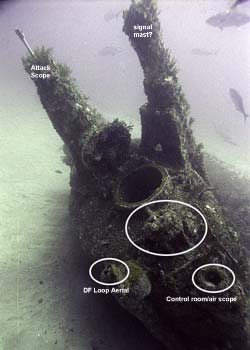 Areas of actual and possible defacing are labeled. Photo courtesy of Paul M. Hudy. |
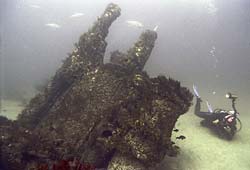 Rear port view of conning tower showing diesel air and boat air inlet masts. Photo courtesy of Paul M. Hudy. |
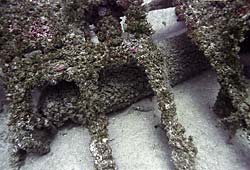 High-pressure air flask - stern. Photo courtesy of Paul M. Hudy. |
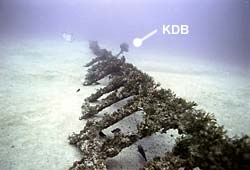 Looking toward bow - KDB - rotating hydrophone device marked. Photo courtesy of Paul M. Hudy. |
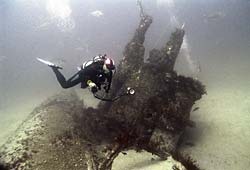 Looking forward behind the conning tower. Photo courtesy of Paul M. Hudy. |
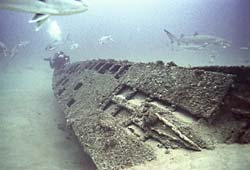 Looking down the deck to the stern. Photo courtesy of Paul M. Hudy. |
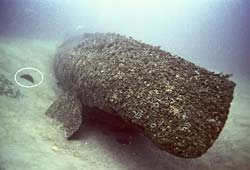 Portside rudder and blade of the port side propeller (circled). Photo courtesy of Paul M. Hudy. |
 Attack periscope. Photo courtesy of Paul M. Hudy. |
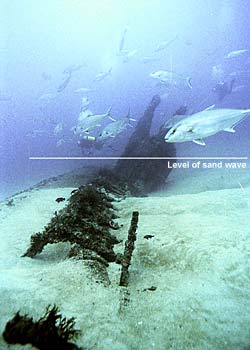 Looking forward from stern - note sand level. Photo courtesy of Paul M. Hudy. |
